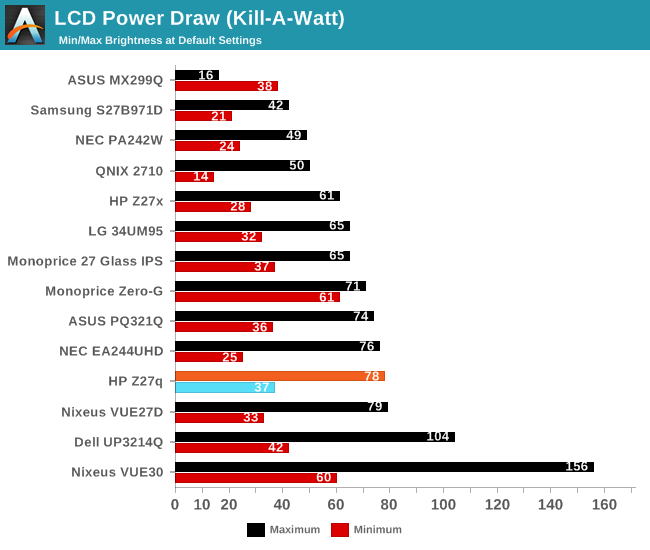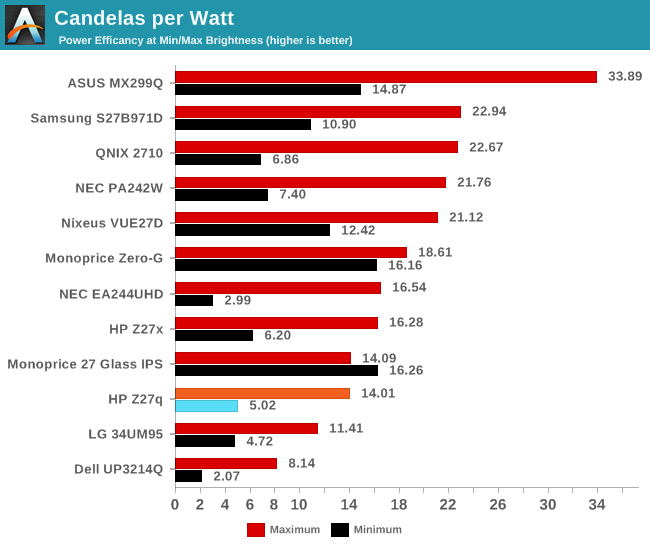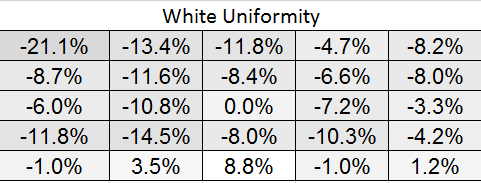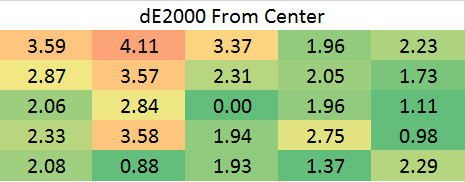HP Z27q Monitor Review: Aiming For More Pixels
by Brett Howse on December 22, 2015 8:00 AM ESTDisplay Uniformity
Having an accurate display is great, but the best displays maintain that accuracy across the entire display. This is challenging for most displays, with larger displays struggling to keep an even backlighting across the entire panel.
White Levels
The HP Z27q suffers from the same issues with uniformity that the Z27x had. There is a significant drop in brightness at the edges of the display. The maximum drop is the upper left corner, where it falls over 20% from the center. The rest of the panel is quite a bit more consistent, but some work could be done here to improve the results.
Black Levels
The black levels are even more inconsistent than the white levels, with the top of the display having the best black levels, and the bottom of the display has the brightest blacks. As a percentage basis, it’s not great.
Color Variation
The error level from the center is, on average, pretty good. There are a couple of areas where the error level is above that of something you would notice, but generally it is pretty close to the same error level as the center. Color uniformity is likely impacted by the same backlight issues that caused the white levels to drop off. Overall, the uniformity results of the Z27q are very similar to the Z27x. There is quite a bit of variation across the panel, and true professionals will likely want a display more accurate than this. At the center, it is very good, but once you move out to the edges, the backlight is quite uneven.
Power Use
Power is measured at the wall with a Kll-A-Watt meter. Measurements are done at both the maximum backlight level, and the minimum backlight level. Maximum brightness is right around 300 nits, and minimum is 51.

The display draws quite a bit of power compared to other 27-inch panels, with a maximum draw of 78 watts at 100% brightness. The minimum power draw is 37 watts, which is once again pretty high. This is not that surprising due to the resolution of this panel, since in order to hit the same brightness levels as a lower resolution display, it is going to need a more powerful backlight due to the transistors in the panel blocking more of the light.
The standby power draw was also quite high. I measured 16 watts at the wall when the display is in standby mode.
Efficiency

Once again, with the high number of pixels, this panel is not going to be as efficient as lower resolution devices. However, it is not as far off as you may think. Candelas per Watt at maximum brightness was 14.01, which is certainly lower than some of the other 27-inch devices, but not excessively so. At minimum brightness the efficiency drops to just 5.02 Candelas per Watt, and more of the power usage is shifted to the electronics of the unit rather than the backlight.















92 Comments
View All Comments
jbrizz - Tuesday, December 22, 2015 - link
I totally agree. There is no point in pushing technology any further beyond this point. In fact, I might take away all but 640k of your RAM, why would anyone need more than that?Spunjji - Tuesday, December 22, 2015 - link
I don't know if you're using Windows 10 or not, but the DPI scaling is getting very good now.hammer256 - Tuesday, December 22, 2015 - link
Frankly, at ~24" viewing distance, 2560x1440 on 27" works pretty excellently for 1:1. I don't want to sit any closer to my monitors, not comfortable for the eyes. If I was going for 4K, I would want something like a 37". Which is huge. And 3 of them? I'll need a bigger desk. I guess with 4K I can make do with just 2 monitors, but once you go triple monitors, you don't go back ;)geok1ng - Thursday, January 7, 2016 - link
Actually, even 32" is way below the confortable reading limit. Most users complain of the PPI on 24" 256x1440 screens, which have a PPI similar to an hypothetical 34" 4k screen. reading at 1:1 4k is impossible for most users even at the 32" monitors. you can not compare with smartphones screens, because the viewing diustance for smartphones is smaller.MatthiasP - Tuesday, December 22, 2015 - link
It's almost double the price of a 4K display, connects via stopgap MST and doesn't bring much improvement in perceived details at arm's length viewing distance over 4K@27".We 4K display owners are still fine, thank you very much.
quickbunnie - Wednesday, December 30, 2015 - link
Problem is, can you even see 5k resolution at 27 inches and a normal viewing distance? You need to be only 21 inches away for a 4k pixel to take up 1 arc minute, nominally considered the limit of average human vision. At this distance, a 27" display takes up 58.5 degrees of you field of vision, which is very large.Even when editing pixel perfect 1:1 4k video, I'm not sure most people will actually be able to see the extra pixels. If you scoot in and look real close, for sure (which I'm sure many professionals do), but I would say 5k does not automatically mean better for most use cases.
LisaValentin3 - Thursday, December 31, 2015 - link
Prima di poter determinare ciò che schermo è giusto per voi, dobbiamo sapere la vostra situazione. Che cosa hai intenzione di utilizzare il portatile per?<a href=http://schermiportatili.it/hp.html>schermo hp</a>
<a href=http://schermiportatili.it/samsung.html>schermo samsung</a>
gonzo98x - Tuesday, December 22, 2015 - link
What's the deal with the price of this monitor when Samsung can squeeze a 4k display into a 6 inch screen and sell it for far less?Doesn't it take a higher level of specialized technology to cram a 4k resolution into such a small display? To me that would mean a phone display should be more expensive or in the case a 27" monitor should cost less.
So where does the cost come from? Or is this simply another example of setting the price for something 'because they can'. We expect it to be expensive so it is expensive?
I'd love to see a teardown and bill of goods for a monitor such as this.
Insert <thesepricesaretoodamnhigh.jpg>
TheStu - Tuesday, December 22, 2015 - link
I imagine it has something to do with the economies of scale. Whoever is making this panel for HP, they're probably looking at less than 100,000 sales (especially if it is NOT the same panel that's in the 27" iMac). Samsung is going to sell tens of millions of their phone displays.bryanlarsen - Tuesday, December 22, 2015 - link
A 6" display has an area of 15 in^2. A 27" display has an area of over 300 in^2. 20x in size, ~20x in cost, where's the disparity?